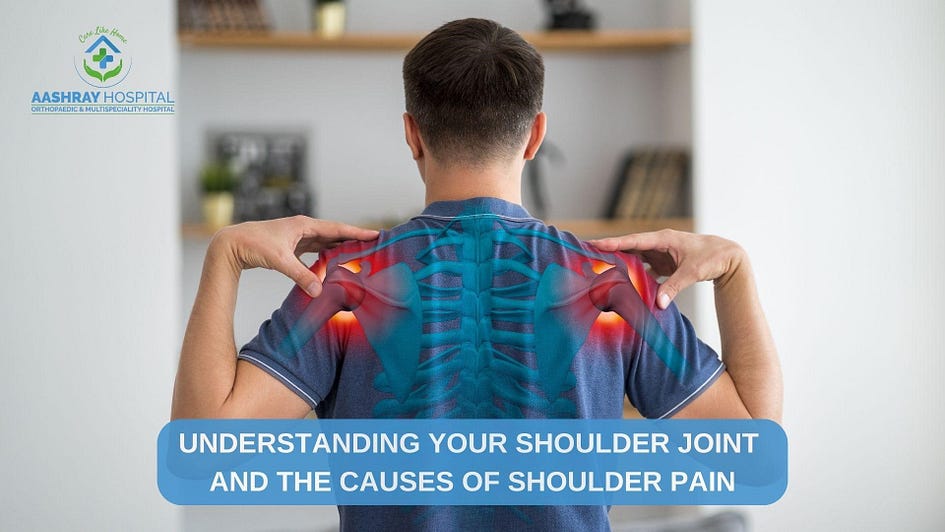
The human shoulder is a remarkable and complex structure that allows for a wide range of motion, from lifting and throwing to reaching and hugging. However, oftentimes this intricate joint is abused to the extent that it is susceptible to a variety of issues that can lead to pain and discomfort. Orthopaedic doctors in Gotri Vadodara, at Aashray hospital have shared special insights about the anatomy of the shoulder and have explained its complex structure for better understanding of the common causes of shoulder pain.
The Anatomy of the Shoulder
The shoulder consists of several key components that work together to provide both stability and mobility. These components include:
1. The Glenohumeral Joint: This is the main ball-and-socket joint of the shoulder, where the rounded head of the upper arm bone (humerus) fits into a shallow socket (glenoid) in the shoulder blade (scapula). It allows for a wide range of motion.
2. The Rotator Cuff: The rotator cuff is a group of four tendons and muscles that surround the glenohumeral joint, providing stability and enabling various shoulder movements. These muscles are the supraspinatus, infraspinatus, teres minor, and subscapularis.
3. The Bursa: A lubricating sac known as the bursa lies between the rotator cuff and the bone. It helps reduce friction during shoulder movements.
4. The Labrum: The labrum is a cartilage ring that lines the glenoid socket and deepens it, providing additional stability to the shoulder joint.
5. Ligaments: Ligaments are strong bands of tissue that hold the bones of the shoulder together, providing stability to the joint.
6. Tendons: Tendons are fibrous connective tissues that attach the muscles to bones, allowing for the transmission of force and movement.
Common Causes of Shoulder Pain
The shoulder’s complexity makes it vulnerable to various issues, and pinpointing the source of pain can be a challenge. Doctors from the best orthopaedic hospitals in Gotri Vadodara share some prevalent causes of shoulder pain:
1. Rotator Cuff Injuries: Injuries to the rotator cuff tendons are a leading cause of shoulder pain. These injuries can occur due to overuse, trauma, or degenerative changes. Symptoms may include pain, weakness, and limited range of motion.
2. Tendinitis: Tendinitis, or inflammation of a tendon, can affect any of the shoulder tendons, often causing pain and discomfort with certain movements. Common types of tendinitis in the shoulder include biceps tendinitis and supraspinatus tendinitis.
3. Bursitis: Inflammation of the bursa, a protective sac in the shoulder, can result in bursitis. This condition can lead to pain, especially during overhead movements.
4. Frozen Shoulder (Adhesive Capsulitis): Frozen shoulder is a condition characterized by the gradual loss of motion in the shoulder joint. It typically progresses through stages and can cause significant pain and stiffness.
5. Labral Tears: Tears in the labrum, the cartilage ring in the glenoid socket, can lead to shoulder pain, instability, and a feeling of “catching” or “popping” in the joint.
6. Arthritis: Osteoarthritis or rheumatoid arthritis can affect the shoulder joint, leading to pain and limited mobility.
7. Fractures: A broken bone in the shoulder, such as a fracture of the collarbone (clavicle) or humerus, can cause acute pain and require immediate medical attention.
8. Nerve Compression: Nerves in the neck and upper back can become compressed or irritated, leading to referred shoulder pain. Conditions like cervical radiculopathy can cause such symptoms.
9. Overuse and Repetitive Strain: Overusing the shoulder through repetitive motions, such as throwing a baseball or lifting heavy objects, can result in shoulder pain, particularly in athletes and laborers.
10. Dislocation: The humerus can become dislocated from the glenoid socket, causing severe pain and instability in the shoulder joint.
Addressing Shoulder Pain
Not all joint pain causes need the joint replacement surgery in Vadodara. Effective management of shoulder pain begins with a proper diagnosis by a healthcare professional. Depending on the underlying cause, treatment options may include:
1. Rest and Activity Modification: In cases of overuse or strain, giving the shoulder time to heal and avoiding aggravating activities is essential.
2. Physical Therapy: Physical therapy can help strengthen the muscles around the shoulder, improve range of motion, and alleviate pain.
3. Medications: Pain relievers and anti-inflammatory medications may be prescribed to manage pain and inflammation.
4. Injections: Corticosteroid injections can provide relief for certain shoulder conditions, reducing inflammation and pain.
5. Surgical Intervention: In severe cases, surgical procedures by any of the best joint replacement surgeons in Vadodara may be necessary.
Conclusion
Ourexperienced and skilled joint replacement surgeon in Gotri Vadodara at Aashray hospital lays stress on understanding the complex structure of your shoulder is the first step toward appreciating the intricate balance between stability and mobility that this joint provides. Whether you’re an athlete, an office worker, or someone in-between, shoulder health is essential to maintaining an active and pain-free lifestyle. If you’re experiencing shoulder pain, don’t hesitate to seek professional medical guidance. By addressing the underlying cause of your shoulder discomfort, you can work towards a healthier, pain-free shoulder and a better quality of life.


Follow us